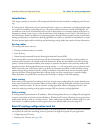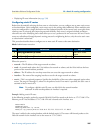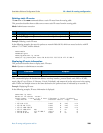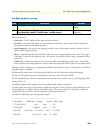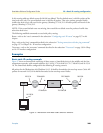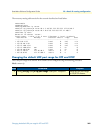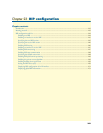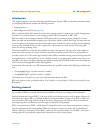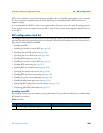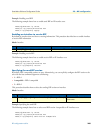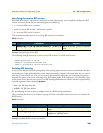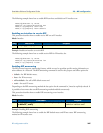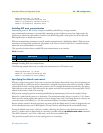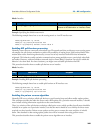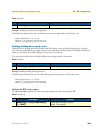
Introduction 243
SmartWare Software Configuration Guide 23 • RIP configuration
Introduction
This chapter provides an overview of the Routing Information Protocol (RIP) and describes the tasks involved
in configuring RIP features includes the following sections:
• Routing protocol
• RIP configuration task list (see page 244)
RIP is a relatively old but still commonly used interior gateway protocol created for use in small, homogeneous
networks. It is a classical distance-vector routing protocol. RIP is documented in RFC 1058.
RIP uses broadcast User Datagram Protocol (UDP) data packets to exchange routing information. Smart-
Nodes can send routing information updates every 30 seconds, which is termed advertising. If a router does not
receive an update from another router for 180 seconds or more, it marks the routes served by the non-updating
router as being unusable. If there is still no update after 240 seconds, the router removes all routing table
entries for the non-updating router.
The metric that RIP uses to rate the value of different routes is the hop count. The hop count is the number of
routers that can be traversed in a route. A directly connected network has a metric of zero; an unreachable net-
work has a metric of 16. This small range of metrics makes RIP an unsuitable routing protocol for large networks
A SmartNode that is running RIP can receive a default network via an update from another router that is run-
ning RIP, or the router can source (generate) the default network itself with RIP. In both cases, the default net-
work is advertised through RIP to other RIP neighbors.
a SmartNode will send and receive RIP information from the specified interface if the following conditions are
met:
• The rip supply flag for a specific interface is enabled
• The rip listen flag for a specific interface is enabled
The default route is learned via a static route and then redistributed into RIP.
RIP sends updates to the specified interfaces. If an interface is not specified, it will not be advertised in any
RIP update.
Routing protocol
Routers exchange information about the most effective path for packet transfer between various end points. There
are a number of different protocols, which have been defined to facilitate the exchange of this information.
Routing Information Protocol (RIP) 1 is the most widely used routing protocol on IP networks. All gateways
and routers that support RIP 1 periodically broadcast routing information packets. These RIP 1 packets con-
tain information concerning the networks that the routers and gateways can reach as well as the number of
routers/gateways that a packet must travel through to reach the receiving address.
RIP 2 is an enhancement of RIP 1 which allows IP subnet information to be shared among routers, and pro-
vides for authentication of routing updates. When this protocol is chosen, the router will use the multicast
address 224.0.0.9 to send and/or receive RIP 2 packets for this network interface. As with RIP 1, the router's
routing table will be periodically updated with information received in these packets.




